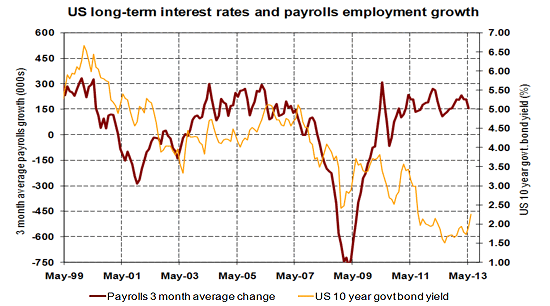
 By Roger J Kerr
By Roger J Kerr
Without fail, it always surprises you to see financial market prices move in the direction you have been expecting however the movement you anticipate to happen over six months occurs in six days!!
Such is the situation with long-term US 10-year Treasury bond interest rates zooming up to 2.57% yield from below 2.00% not so long ago.
The bond markets may well have over-reacted short-term to the Federal Reserve’s confirmation of tapering back QE, however any removal of a massive buyer from the market is always negative for any price.
There have been a series of false starts for rising long-term interest rates in recent years and this has dissuaded some investors and borrowers from shortening and lengthening their respective portfolio durations up until now.
The increase in yield is sustainable as every fixed interest fund manager in the world will now be under enormous pressure to shorten portfolio duration to limit the negative returns.
The argument that inflation is low in the US today and will remain low in the future as a reason why interest rates will not increase much loses its appeal when 10-year yields jump 0.80% in a few days. A 0.80% increase on a 1.70% interest rate is one very large change in anyone’s language.
While one can debate where the new norms are for US and NZ interest rates post GFC, the chart below tells me that US 10-year Treasury bond yields still have a very long way to go in the new trend upwards
I do not expect to see 5.00% US Treasury bond yields anytime soon, however 4.00% cannot be ruled out sometime over the next 12 months.
A 1.40% increase on NZ 10-year swaps currently at 4.70% is hitting above 6.00%.
Those borrowers that viewed inflation as dead and thus did not fix long-term have just had a sharp and expensive lesson in interest rate risk management.
If you wait for the certain confirmation that interest rates are rising, the rate you fix at will always be higher than that achieved by the risk manager who progressively fixes on the way down.

-----------------------------------------------------------
To subscribe to our daily Currency Rate Sheet email, enter your email address here.
US Treasury Bonds
Select chart tabs
Roger J Kerr is a partner at PwC. He specialises in fixed interest securities and is a commentator on economics and markets. More commentary and useful information on fixed interest investing can be found at rogeradvice.com
3 Comments
And with the higher cost of mortgage debt...bang goes the so called recovery in NZ...not that Bill English will mind as he sucks in the extra tax revenue on higher deposit returns!
So what will the covered bond refi costs be....anyone like to guess!
Watch carefully as the rates rise for debt but drag along the ground for deposits...nothing to do with fleecing the savers and don't you dare suggest the banks act in unison...
The argument that inflation is low in the US today and will remain low in the future as a reason why interest rates will not increase much loses its appeal when 10-year yields jump 0.80% in a few days. A 0.80% increase on a 1.70% interest rate is one very large change in anyone’s language.
While one can debate where the new norms are for US and NZ interest rates post GFC, the chart below tells me that US 10-year Treasury bond yields still have a very long way to go in the new trend upwards
Hmmm - who are the losers? - and how much collateral (other people's money) are they being forced to post against marked to market losses? Read on
In view of the pending introduction of OBR could ANZ enlighten the depositor funding backbone of the curious but as yet unexplained risks associated with the derivative positions set out in Note 11 document pages 25 -26 in the the last annual disclosure statement?
And now this - just to give those on the other side a chance to lose a bit.
“This isn’t a good time to sell Treasuries,” said Akira Takei, who helps oversee the equivalent of $34 billion as the head of the international fixed-income department in Tokyo at Mizuho Asset Management Co. “China’s credit squeeze may have more severe repercussions for the global economy than we saw after Lehman’s collapse,” he said, referring to the bankruptcy of Lehman Brothers Holdings Inc. in 2008.

We welcome your comments below. If you are not already registered, please register to comment
Remember we welcome robust, respectful and insightful debate. We don't welcome abusive or defamatory comments and will de-register those repeatedly making such comments. Our current comment policy is here.